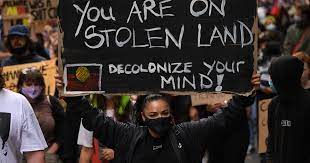STRUCTURAL VIOLENCE AGAINST AUSTRALIA'S INDIGENOUS PEOPLE - LUISA ANDALL - AUSTRALIA
- makfor9
- 21 nov 2021
- Tempo di lettura: 3 min
The colonisation of Australia was premised on the exploitation of the Indigenous people, their land and its natural resources. The settler-society desired unlimited access to the land and natural resources, which were exploited and commodified to generate economic growth. The existence of the Indigenous people were an obstacle to this that needed to be removed or eliminated. This historical displacement and dispossession of Indigenous people from their land was largely achieved through direct violence. However, in its contemporary manifestation, the displacement and dispossession of Indigenous communities is structural.
It comes in the more specific form of environmental displacement and dispossession, seen as a process through which the land occupied by a particular community is progressively altered to the point where it is uninhabitable. This displacement and dispossession is inherently ‘environmental’, as it is justified by an environmental rationale that is underpinned and motivated by a desire to access the natural resources of that land. This land and its resources are then exploited and commodified for economic gain; a ‘colonial refashioning’ of the land that echoes the original colonial objective. Environmental displacement and dispossession also accounts for the inherent political nature of displacement and dispossession and the power structures within it. It demonstrates how a more powerful individual or group can transform an environment for their economic benefit, in a way that provokes the displacement and dispossession of another.
Through environmental displacement and dispossession, Indigenous communities are restricted in their access to their land and their traditional use of it. This gradually eliminates the land from sight, which, in turn, structurally eliminates Indigenous culture and identity from sight. Land becomes a source of power, control and economic revenue. This is in contrast to an Indigenous understanding of land, where is not a material object, rather a ‘way of knowing, of experiencing and relating to the world and with others’.
Since European invasion, mining has significantly contributed to the environmental dispossession and displacement of Indigenous people from their land. The Australian government and mining corporations have repeatedly sought Indigenous land for the expanding mining industry. An industry that generates an extensive amount of economic revenue. In a study of mining in Australia, relative to Indigenous communities and land, academic Dr. Benedict Scambary found that decision-making regarding mines, their location and their potential approval, consistently favoured ‘mainstream economic development’ for the government or mining corporation, at the expense of Indigenous communities. This prioritisation of economic gain demonstrates an existence of ‘colonial capitalism’, tied to a racialised, Eurocentric ideal of economic and industrial growth, progress and development that reproduces colonial power relations. When predicated on a desire to continuously expand colonial industries, this ideal becomes a controlling force that structurally and systematically subjugates Indigenous peoples, their land and their rights. Under this logic, environmental displacement and dispossession of Indigenous communities from mining is seemingly justified and rationalised, in the name of profit and economic gain.
There are a myriad of mines in Australia that exemplify the structural environmental displacement and dispossession of Indigenous communities. Mines in New South Wales, Queensland and Western Australia will all destroy the land occupied by Indigenous groups for thousands of years. This destruction of Indigenous land cannot occur without legislative support and approval from government. Coal mining is particularly complicated by its measurable exacerbation of climate change. Indigenous Australians are particularly vulnerable to climate change due to existing social and economic disadvantage and their strong dependence on land for food, health and culture. Therefore, their environmental displacement and dispossession becomes the result of two causes; initial, direct displacement and dispossession from land that will be mined, and gradual displacement and dispossession from land that becomes progressively uninhabitable due to the negative effects of climate change.
The mentality and belief that Indigenous people, their land and their rights can be justifiably subordinated in the name of economic growth is entrenched in the psyche of settler-colonial Australia. It has cultivated and sustained seemingly justifiable and permissible structural violence towards Indigenous people, that manifests as the environmental displacement and dispossession of these communities. Under this mentality, economic growth is desirable, yet the protection of Indigenous communities is impermissible as it stands as an obstacle to the sustainment of the mining industry. They are mutually exclusive.




Commenti